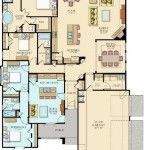Essential Aspects of Simple Floor Plan Design With Measurements
A well-designed floor plan is crucial for creating a functional and visually appealing living space. Whether you're designing a new home or renovating an existing one, incorporating measurements into your floor plan is essential for ensuring accuracy and maximizing space utilization.
1. Determine the Room Layout
Start by sketching out the basic layout of each room, including the placement of walls, windows, and doors. Consider the flow of traffic and natural light when determining the arrangement of furniture and fixtures.
2. Measure Room Dimensions
Use a tape measure to accurately measure the length and width of each room. Record the dimensions in feet and inches, noting any irregularities or alcoves.
3. Mark Wall Openings
Measure the width and height of all windows and doors. Note their placement within the walls, including any offsets or archways.
4. Identify Fixed Elements
Locate and measure any permanent structures that cannot be moved, such as fireplaces, built-in cabinets, or stairwells. These elements must be accounted for when planning the layout and furniture placement.
5. Plan Furniture Layout
Use graph paper or digital design software to scale down the room dimensions and create a floor plan to scale. Experiment with different furniture arrangements to optimize space utilization and create a comfortable living environment.
6. Add Measurements to the Plan
Label all measurements clearly on the floor plan. This includes room dimensions, window and door measurements, and the placement of fixed elements. The measurements should be legible and accurate.
7. Consider Scale and Proportions
Ensure that the furniture and fixtures are appropriately scaled to the size of the room. Overcrowding or under-furnishing can create visual imbalances. Use a scale for accuracy when measuring and planning the layout.
8. Incorporate Lighting and Utilities
Mark the locations of electrical outlets, switches, and light fixtures. This information is crucial for planning furniture placement and ensuring adequate lighting in all areas.
9. Include Notes and Details
Add notes to the floor plan to indicate any special requirements, such as wheelchair accessibility, storage needs, or additional features. These notes will help guide the construction or renovation process.
10. Review and Adjust
Once the floor plan is complete, it's essential to review it thoroughly and make any necessary adjustments. Consult with an architect or designer if required to ensure that the floor plan meets all building codes and regulations.
Conclusion
Creating a simple floor plan with accurate measurements is a fundamental step in any interior design or architectural project. By following these essential aspects, you can design a functional, comfortable, and aesthetically pleasing space that meets your specific needs.

12 Examples Of Floor Plans With Dimensions

Floor Plans With Dimensions Including Examples Cedreo

12 Examples Of Floor Plans With Dimensions

Floor Plans Learn How To Design And Plan

5 Small And Simple 2 Bedroom House Designs With Floor Plans In 2024 Design Es Plan

Simlpe House Design Floor Plan Template

2d Floor Plans Metal Building House Small Kitchen Design Home

Est House Plans To Build Simple With Style Blog Eplans Com

Low Budget Simple House Design Plans For Builders Blog Builderhouseplans Com

Simple House Plans Blog Homeplans Com
Related Posts








